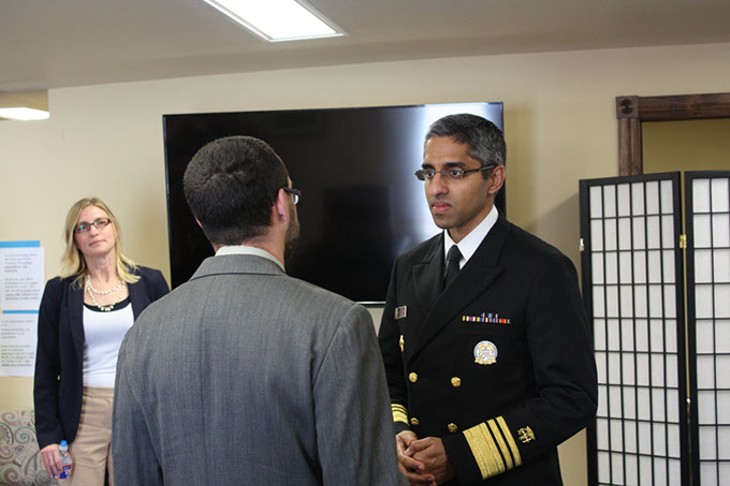
Karin Leimbach guided a group of Metro Technology Center students outside to a cluster of trees. The teenagers wrapped purple ribbons around a tree trunk, leaving space for passersby to read the poster’s message: “Strong as One. Stronger Together.”
The activity followed a discussion on Oklahoma County’s prescription drug epidemic. Last year, 118 Oklahoma County residents died with at least one prescription drug in their system, according to the Coalition Against Rx Drug Epidemic (C.A.Rx.E.).
It’s a distressing number, but coalition member Leimbach contends that teens hold great influence on the issue.
Leimbach told Oklahoma Gazette about her message to youth.
“You have a voice. You can help prevent this,” she said. “I think turning this into a conversation on what you can do to prevent this and how you can advocate on this issue really helps to empower the teens.”
As a C.A.Rx.E. member, Leimbach visits schools, health fairs, community events — wherever the coalition is invited. Listeners hear a somber message presented by Leimbach and fellow C.A.Rx.E. members; however, the abuse of prescription pain medication and the addiction crisis is also arguably one of the biggest issues.
The countless number of deaths in Oklahoma and across the United States has prompted one federal agency to issue new guidelines on prescribing practices and another to dole out $94 million to fight opioid addiction in communities across the country, including Oklahoma City and Midwest City. Along the campaign trail, presidential candidates have touched on the travesty of overdose deaths. Rumors that Percocet was involved in music star Prince’s recent death placed the issue of prescription drug abuse in national news and entertainment media reports.
In Oklahoma City, occasionally someone who has seen a family member or a friend struggle with an addiction to prescription opioids approaches Leimbach. In those moments, a dialogue opens about the problem and how to address it with solutions, including C.A.Rx.E. The coalition, which was formed in 2014, strives to decrease Oklahoma County’s prescription drug epidemic through education, awareness and other prevention activities. Mostly, the coalition strives to bring the subject of prescription drug abuse to the forefront. It can no longer be a taboo subject.
“I feel our society does a really good job talking with teens about drugs, alcohol and marijuana,” said Leimbach, “but we forget about what’s in our medicine cabinets.”
C.A.Rx.E. coalition members advocated for all sectors of the community to play a role in fighting prescription drug abuse during National Prevention Week, observed May 17-23 and sponsored by the Substance Abuse and Mental Health Services Administration. The message matched that of U.S. Surgeon General Vivek Murthy during his three-day visit to Oklahoma during National Prevention Week.
“The truth is, to address this problem, we are going to need all parts of the community working together,” Murthy told Oklahoma media during his May 17 visit. “This is not a problem that is going to be solved by policy or by one set of programs alone. It is going to be solved by people coming together and doing their part to educate each other to make sure they are protecting their family members.”
Oklahoma’s story
Oklahoma’s drug overdose rate increased fivefold from 1999 to 2013, and in 2013, the Sooner State ranked sixth in unintentional overdose deaths in the United States, according to the Oklahoma State Department of Health.
But Oklahoma has been taking meaningful measures to reverse the trend. The state comprehensive plan, Reducing Prescription Drug Abuse in Oklahoma, was developed in 2013 to address the growing epidemic. Recommendations include the Oklahoma Bureau of Narcotics growing the number of drop boxes for unused and unwanted prescriptions, enhancing the Prescription Monitoring Program and establishing legislation to allow naloxone — a drug used to reverse the effects of an opioid overdose — to be used by family members and first responders. The plan called for increased funding to the Oklahoma Department of Mental Health and Substance Abuse (ODMHSA) for expansion of community-based services for treatment of opioid dependency.
State laws now require physicians to regularly check the state’s prescription drug monitoring program, which tracks prescriptions filled for schedule II, III, IV and V controlled substances. Additionally, law enforcement agencies are training officers on naloxone.
Terri White, the state’s mental health commissioner, shared stories of those efforts with Murthy during his visit to Oklahoma City. White met Murthy for a tour of Catalyst Behavioral Services, which is reimbursed for its addiction services by ODMHSA.
“I think one of the most important things that the Surgeon General brings to us is hopefully a new level of attention,” White said. “The fact is he is impressed with the efforts Oklahoma is making. At the same time, we have a long way to go, despite the fact that we are on a downturn because of the work done across the state.”
With the state revenue failure, White’s department was forced to cut $22.8 million from the current year’s budget, impacting operations and services. An estimated 73,000 Oklahomans are impacted by the reduced services. Progress in prevention and treatment is at risk with potential fewer dollars distributed to the agency for the coming fiscal year, which begins July 1.
“Our biggest challenge,” White said, “is the lack of resources for everyone to access.”
Murthy’s visit
Oklahoma parents who lost their son to a prescription drug overdose in 2011, an Oklahoma City man who broke free from his prescription drug addiction a year ago and Shawnee tribal leaders and youth shared their experiences of the opioid epidemic with Murthy, the nation’s top physician.
Murthy said the stories were similar to those he heard during his stops in Baltimore, Maryland, and Jacksonville, Florida. He is creating the first Surgeon General’s report on substance use, addiction and health, which is expect to be released this fall.
“People are starting to come out of the shadows,” Murthy said. “This is important because in addition to making sure we fund treatment and improve prescribing practices, we have to address the stigma which is still associated with addiction. That stigma prevents people from coming forward to ask for help.”
Following the March release of the Center for Disease Control and Prevention recommendations for prescribing opioid medications, Murthy began the tour of cities and communities hardest hit by the epidemic. His visits’ primary purposes are twofold: educate prescribers on the new regulations and talk with the public. Part of his message to communities is to see addiction as a chronic illness that needs to be treated with skill, urgency and compassion.
“Treatment saves lives,” Murthy said. “Sometimes people say, ‘We can’t afford to build [treatment] centers.’ I say, ‘We can’t afford not to have treatment.’ The cost of not getting people the help they need is far greater.”
Print Headline: Community solution, The U.S. Surgeon General’s message rivals work by a local coalition and state agency to combat opioid addiction.










